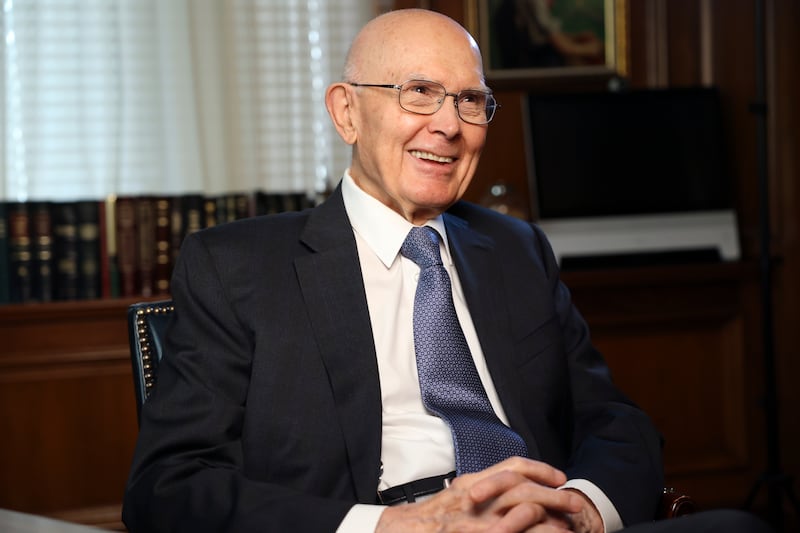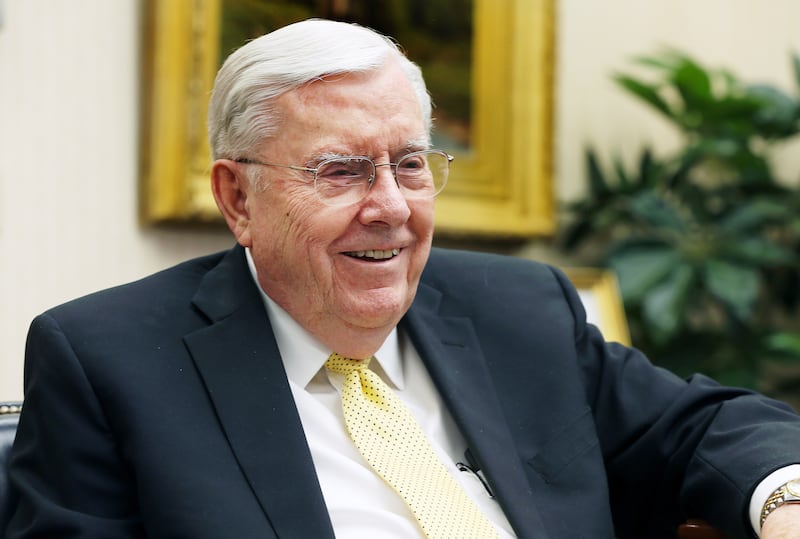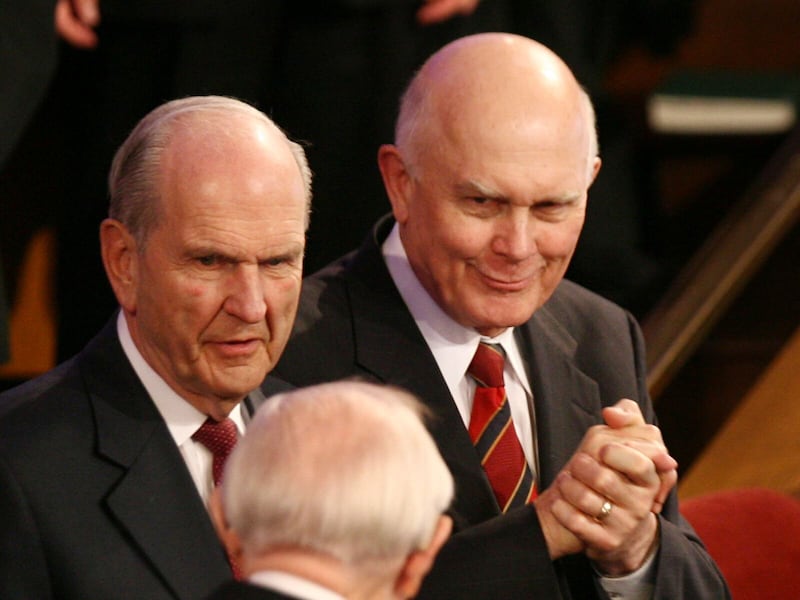This article was first published in the ChurchBeat newsletter. Sign up to receive the newsletter in your inbox each Wednesday night.
The death of President Russell M. Nelson automatically dissolved the First Presidency on Saturday night and launched an apostolic interregnum — a period when the Quorum of the Twelve Apostles leads The Church of Jesus Christ of Latter-day Saints.
The end of a First Presidency that lasted more than seven-and-a-half years means that Presidents Dallin H. Oaks and Henry B. Eyring have returned to the Quorum of the Twelve.
That means the quorum temporarily has 14 members with the senior apostle, President Oaks, as its president.
An apostolic interregnum is a rare moment in the church, Elder Jeffrey R. Holland told the Deseret News in 2018.
“It’s a great thing in the church to say goodbye to a prophet and anticipate a new one,” he said. “Through all the anticipation of it all, there’s never a moment when the keys are not in force, and there’s never any lack of revelatory experience. It’s a little bit like the Brits, who say, ‘the King is dead. God save the king.’ The transition is that fast.”
Throughout the church’s 195-year history, every apostolic interregnum has ended with the quorum selecting the senior apostle as the next church president.

President Oaks, 93, is therefore expected to succeed President Nelson — a friend he literally sat next to in leadership meetings for 41 years — and become the 18th prophet-president of the church.
The second-most senior apostle becomes the president of the Quorum of the Twelve Apostles. During President Nelson’s tenure, that meant President Oaks carried that title while he served as the first counselor in the First Presidency.
Two men served as acting president of the quorum during that time:
- President M. Russell Ballard, from January 2018 to his death in November 2023.
- President Jeffrey R. Holland from 2023 to Saturday.
Seniority is determined not by age but by service in the quorum.
President Holland, 84, is now the second-most senior apostle and is expected to be set apart as president of the Twelve. If he were called to the new First Presidency when it is reorganized, the next-senior apostle, President Eyring, 92, would become acting president of the Twelve.
Based on church precedent, the First Presidency is not expected to be reorganized before general conference this weekend, though it is possible.
In the past, out of respect for the deceased church president, the First Presidency has not been reorganized until after his funeral. President Nelson’s funeral is scheduled on Tuesday, Oct. 7.

President Ballard talked about that respect in a Deseret News interview during the last apostolic interregnum in 2018.
“In reverence to the deceased president, we just don’t do much prior to the funeral,” he said.
Part of the reason is also respect for the following First Presidency, he said.
“There’s not much to talk about, really, not much you can say or do or decide because there will be a new First Presidency,” he said.
In 2018, after the death of President Thomas S. Monson, the apostolic interregnum lasted for 12 days.
That was the longest interregnum since the church’s pioneer days. (See chart at bottom.)
That 2018 interregnum ended when the Quorum of the Twelve set apart President Nelson as the President Monson’s successor during a Sunday morning meeting in the Salt Lake Temple.
If the quorum again chooses to hold its succession meeting the Sunday after the funeral, a new president might not be announced until Oct. 12, 13 or 14, due to this weekend’s general conference meetings.
The new church president will call two apostles from the quorum to assist him in the First Presidency. That will reduce the quorum to 11 members.
The new church president then will be expected to name a new apostle.
Generally, that has happened at general conferences, but two members of the quorum were called between conferences:
- President Holland was called in June 1994.
- Elder Patrick Kearon joined the quorum in December 2023.
Apostles serve for life and are, according to Latter-day Saint scripture, “special witnesses” of Jesus Christ to the world. Three apostles form the First Presidency. Twelve more make up the Quorum of the Twelve Apostles.

President Nelson and President Oaks were called as apostles together in 1984. President Nelson was designated as the senior of the two apostles.
President Oaks was born in Provo, Utah, in August 1932. He and his late wife, June Dixon Oaks, are the parents of six children. She died in 1998, and in 2000, he married Kristen M. McMain in the Salt Lake Temple.
Elder Oaks clerked for Chief Justice Earl Warren at the U.S. Supreme Court from 1957 to 1958. He practiced law in Chicago and then taught law at the University of Chicago.
He was president of Brigham Young University from 1971 1980 and a justice of the Utah Supreme Court from 1980 until his resignation in 1984, when he accepted the call to the apostleship.
My Recent Stories
Elder Bednar ministers in Michigan to the victims of Sunday’s deadly attack (Sept. 30)
For other Latter-day Saint wards in Michigan, Sunday was traumatic, too: ‘A huge violation’ (Sept. 30)
Michigan bishop: We are ‘quite shaken’ but leaning on Jesus Christ, each other and Grand Blanc (Sept. 29)
An eyewitness account from Michigan: Latter-day Saints under gunfire fought to save each other (Sept. 29)
4 dead following shooting, fire at Latter-day Saint church in what FBI calls ‘targeted violence’ (Sept. 28)
See reactions to the life and death of President Russell M. Nelson (Sept. 28)
President Russell M. Nelson — a man of heart, hope and vision — has died at age 101 (Sept. 27)
About the church
Six church leaders honored President Russell M. Nelson during a unique tribute broadcast on Wednesday.
A public viewing for President Nelson is open to visitors of all ages on Monday, Oct. 6, from 9 a.m. to 8 p.m. in the Conference Center in Salt Lake City.
President Nelson’s funeral will be held at noon on Tuesday, Oct. 7 at the Conference Center. Find more details here.
God’s guidance is steady, even after a prophet’s death, wrote the Deseret News editorial board.
Here’s how to watch, listen and follow general conference on Saturday and Sunday.
President Nelson’s teachings highlighted Saturday’s groundbreaking ceremony for the Fairbanks Alaska Temple. Leaders also broke ground on Sept. 25 for the Lone Mountain Nevada Temple.
Sister Amy A. Wright of the Primary General Presidency said the Family Proclamation is “inseparably connected” to Jesus Christ at a BYU conference, where a professor said called it “God’s eternal vision of who we are.”
See an update on the Salt Lake Temple renovation.
What I’m reading
I had the honor once of meeting, interviewing and writing about Hall of Fame basketball coach and human being John Wooden. I came across this short video of the late Bill Walton describing some of his remarkable teachings about life.
President Trump posted a tribute to President Nelson.
Some Colorado University fans directed profane chants at BYU and “Mormons” during the CU-BYU football game on Saturday. The Big 12 fined CU $50,000, calling it “hateful and discriminatory language.” Colorado coach Deion Sanders apologized to BYU.
The Catholic Church is growing. Its priesthood isn’t, the Wall Street Journal reported.
President Nelson saw me for who I had the potential to become
I loved browsing through this photo gallery of President Nelson.
Lengths of apostolic interregnums
1) Three years, 6 months: Joseph Smith to Brigham Young, June 27, 1844-sustained Dec. 27, 1847.
2) Three years, 1 month: President Young to John Taylor, Aug. 29, 1877-sustained Oct. 10, 1880.
3) One year, 9 months: President Taylor to Wilford Woodruff, July 25, 1887-sustained April 7, 1889.
4) 11 days: President Woodruff to Lorenzo Snow, Sept. 2, 1898-Sept. 13, 1898.
5) 7 days: President Snow to Joseph F. Smith, Oct. 10, 1901-Oct. 17, 1901.
6) 4 days: President Smith to Heber J. Grant, Nov. 19, 1918-Nov. 23, 1918.
7) 7 days: President Grant to George Albert Smith, May 14, 1945-May 21, 1945.
8) 5 days: President Smith to David O. McKay, April 4, 1951-sustained April 9, 1951.
9) 5 days: President McKay to Joseph Fielding Smith, Jan. 18, 1970-Jan. 23, 1970.
10) 5 days: President Smith to Harold B. Lee , July 2, 1972-July 7, 1972.
11) 4 days: President Lee to Spencer W. Kimball, Dec. 26, 1973-Dec. 30, 1973.
12) 5 days: President Kimball to Ezra Taft Benson, Nov. 5, 1985-Nov. 10, 1985.
13) 6 days: President Benson to Howard W. Hunter, May 30, 1994-June 5, 1994.
14) 9 days: President Hunter to Gordon B. Hinckley, March 3, 1995-March 12, 1995.
15) 7 days: President Hinckley to Thomas S. Monson, Jan. 27, 2008-Feb. 3, 2008.
16) 12 days: President Monson to Russell M. Nelson, Jan. 2, 2018-Jan. 14, 2018.
17) Sept. 27, 2025-current.


